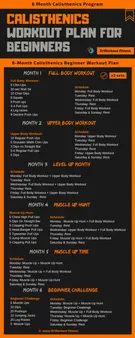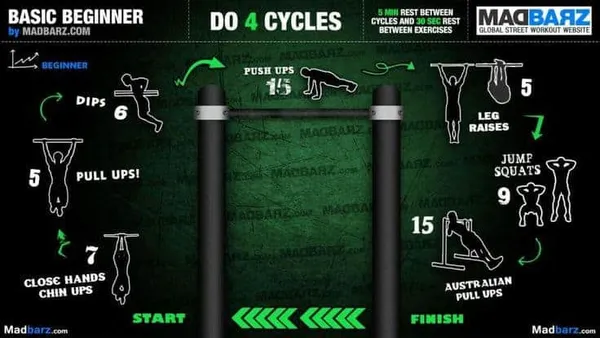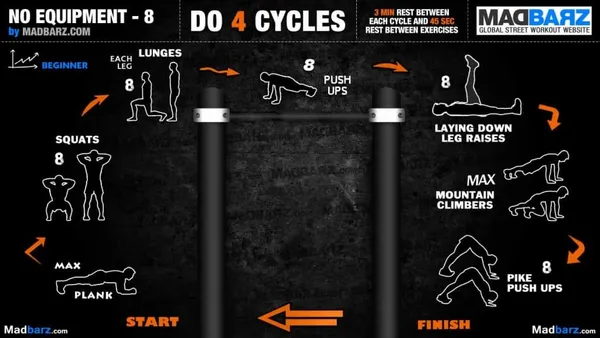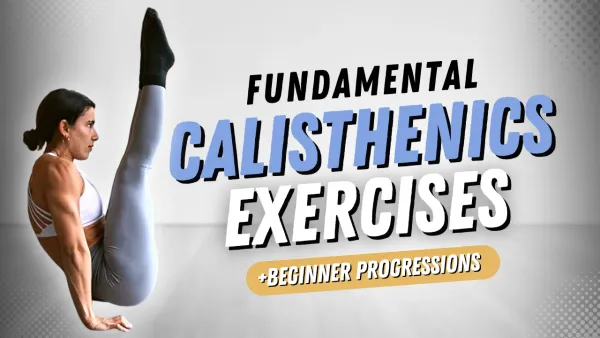Table of Contents
Are you a beginner looking to get started with calisthenics? Calisthenics is a great way to get in shape, build strength, and improve your overall fitness. It's also a lot of fun! In this article, we'll provide you with a beginner calisthenics routine that you can follow to get started. We'll also provide tips on how to progress your routine as you get stronger. So what are you waiting for? Get started today and see the amazing results that calisthenics can bring!
Calisthenics Routine for Beginners: A Comprehensive Guide to Get You Started
Calisthenics Exercise | Benefits | Difficulty |
|---|---|---|
Bodyweight Squats | Builds lower body strength, improves mobility | Beginner |
Push-Ups | Strengthens upper body, improves core stability | Beginner |
Plank | Engages core muscles, improves posture | Beginner |
Lunges | Improves leg strength, balance, and coordination | Beginner |
Burpees | Full-body workout, boosts cardiovascular fitness | Intermediate |
Pull-Ups | Strengthens back and arms, improves grip strength | Intermediate |
Dips | Targets triceps and chest muscles, improves upper body strength | Intermediate |
Handstand Push-Ups | Advanced exercise, strengthens shoulders, core, and wrists | Advanced |
I. Calisthenics Routine for Beginners: A Comprehensive Guide
Calisthenics is a great way to get in shape and improve your overall fitness. It is a form of bodyweight training that uses your own body weight as resistance. This makes it a versatile and accessible form of exercise that can be done anywhere, anytime. While calisthenics is a great way to get in shape, it can be difficult to know where to start if you are a beginner. This beginner's guide to calisthenics will provide you with everything you need to know to get started on your journey to a healthier, fitter you.
II. Essential Exercises for Building a Strong Foundation
Before you can start getting advanced, you need to build a solid foundation. This means focusing on exercises that will help you build strength and flexibility in your major muscle groups. Some essential exercises for beginners include:
These exercises will help you build a strong foundation and prepare you for the more advanced calisthenics exercises such as muscle-ups, handstand push-ups, and pull-ups.
Exercise | Benefits |
|---|---|
Pull-Ups | Strengthens back and arms, improves grip strength |
Dips | Targets triceps and chest muscles, improves upper body strength |
Handstand Push-Ups | Advanced exercise, strengthens shoulders, core, and wrists |
Calisthenics Routine for Beginners: A Comprehensive Guide
III. Essential Exercises for Building a Strong Foundation
Bodyweight Squats: A Beginner's Guide
Bodyweight squats are a great way to build lower body strength and improve mobility. They are a compound exercise, meaning they work multiple muscle groups at once, including the quads, hamstrings, glutes, and core. Bodyweight squats are also a great way to improve balance and coordination. Learn more about bodyweight squats here
Push-Ups: A Cornerstone of Calisthenics
Push-ups are another great exercise for beginners. They strengthen the upper body, including the chest, triceps, and shoulders. Push-ups are also a great way to improve core stability. Learn more about push-ups here
Exercise | Benefits | Difficulty |
|---|---|---|
Bodyweight Squats | Builds lower body strength, improves mobility | Beginner |
Push-Ups | Strengthens upper body, improves core stability | Beginner |
Plank | Engages core muscles, improves posture | Beginner |
Lunges | Improves leg strength, balance, and coordination | Beginner |
Essential Exercises for Building a Strong Foundation
IV. Progressive Overload: Gradually Increasing Intensity
The principle of progressive overload is essential for continuous improvement in calisthenics. It involves gradually increasing the intensity of your workouts over time, which forces your body to adapt and become stronger.
There are several ways to apply progressive overload to your calisthenics routine. One method is to increase the number of repetitions or sets of an exercise. For example, if you start by doing 10 push-ups, you can gradually increase the number to 12, 15, and so on.
Calisthenics Exercise | Progression | Benefit |
|---|---|---|
Bodyweight Squats | Increase depth, add weight | Builds lower body strength, improves mobility |
Plank | Increase hold time, add variations | Engages core muscles, improves posture |
Dips | Add weight, increase repetitions | Targets triceps and chest muscles, improves upper body strength |
Another way to increase intensity is to make the exercises more challenging. For example, instead of doing regular push-ups, you can try decline push-ups or plyometric push-ups. These variations require more strength and coordination.
Frequency and Recovery
When implementing progressive overload, it's important to consider frequency and recovery. Gradually increasing the frequency of your workouts can help you progress faster, but it's important to listen to your body and rest when needed.
Adequate recovery is crucial for muscle growth and repair. Aim for at least 24 hours of rest between workouts for the same muscle group. During rest days, engage in light activities like stretching or yoga to promote blood flow and aid in recovery.
Progressive Overload: Gradually Increasing Intensity
V. Tips for Staying Motivated and Consistent
Set Realistic Goals
Don't try to do too much too soon. Start with a few simple exercises and gradually add more as you get stronger. If you set your sights too high, you're more likely to get discouraged and give up.
Related post: How to Design Your Own Calisthenics Routine and Program
Find a Workout Buddy
Having someone to workout with can help you stay motivated and accountable. Find a friend, family member, or coworker who is also interested in getting fit and schedule regular workouts together.
Related post: The Best Calisthenics Exercises and Variations
Make It Fun
If you don't enjoy your workouts, you're less likely to stick with them. Find exercises that you enjoy and that challenge you. If you're not sure where to start, there are plenty of online resources and videos that can help you find exercises that are right for you.
Related post: The Benefits of Calisthenics for Bodyweight Training
Track Your Progress
Seeing how far you've come can be a great motivator. Keep a journal or use a fitness tracker to track your workouts and progress. This will help you stay on track and motivated to keep improving.
Related post: How to Build Muscle and Strength with Calisthenics
Reward Yourself
When you reach a goal, reward yourself with something you enjoy. This will help you stay motivated and make it more likely that you'll continue to work hard.
Related post: The Best Calisthenics Equipment and Gear
Calisthenics Exercise | Benefits | Difficulty |
|---|---|---|
Bodyweight Squats | Builds lower body strength, improves mobility | Beginner |
Push-Ups | Strengthens upper body, improves core stability | Beginner |
Plank | Engages core muscles, improves posture | Beginner |
Lunges | Improves leg strength, balance, and coordination | Beginner |
Burpees | Full-body workout, boosts cardiovascular fitness | Intermediate |
Pull-Ups | Strengthens back and arms, improves grip strength | Intermediate |
Dips | Targets triceps and chest muscles, improves upper body strength | Intermediate |
Handstand Push-Ups | Advanced exercise, strengthens shoulders, core, and wrists | Advanced |
Tips for Staying Motivated and Consistent
VI. Conclusion
Congratulations on taking the first step towards a healthier and fitter you! Remember, consistency is key. Stick to your calisthenics routine as much as possible, and you will start to see results in no time. If you ever feel like giving up, just think back to why you started in the first place. And if you need any more motivation, be sure to check out the kizworld website for more tips and advice on calisthenics and other fitness topics.